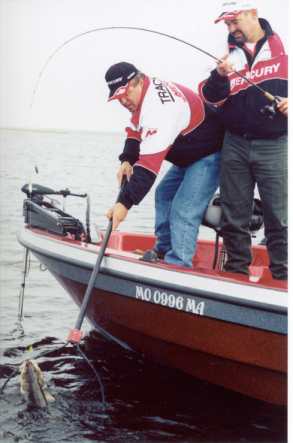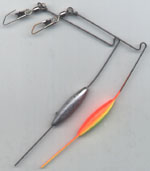 |
|||||


Free 90 day Risk free trial offer click here
|
Bottom Bouncers As Easy As 1,2,3 By Rick Olson More and more anglers are finding out just how effective bottom bouncing
can be. Initial reactions may include questioning why a finicky walleye
would even come close to something as clunky as a bouncer, but don’t
let that bother you, as the walleyes sure don’t seem to mind. In fact,
the big clunky, hunk of burning love, may even act as an attractor.
Painted models have been to known to acquire teeth marks, which are the
direct result of a savage walleye attack. It may also explain a few of
the missed fish, that occasionally happens.
Bait casting equipment is the way to go, when pulling bouncer and spinner combinations. Medium action rods in the six and a half foot range, cover most applications. Reels with a flippin’ feature are preferred, as they allow you to let out more line with one hand, which can be a big advantage when you’re working with two rods. When things get a little tough and a spinner presentation is getting passed up, you may have to scale down, and slow down, to keep catching fish. Tough times call for light bite tactics, like live bait rigging. But instead of the usual walking type sinker that is prone to snagging up, you’re better off by using an ultra-light bouncer with a plain hook and a long snell. Bouncers in the 3/4 oz. range are the way to go, along witha snell of five or six feet in length, or more. The extra long snell will give your bait some room to roam, and buy you some extra time, after a strike. Live bait options include minnows, leeches, and crawlers. To get the most out of a minnow, try hooking it just under the dorsal fin. This method will allow the minnow to kick and swim for all it’s worth, and can drive walleyes nuts. Leeches work best when hooked through the sucker, which leaves them free to swim up and off the bottom, but requires a dead slow trolling speed. Crawlers can be hooked one of three ways, and includes once through the tip, through the middle (creating a double trailer), and using half of a crawler thread completely onto the hook. The half crawler technique can be particularly effective when dealing withwalleyes showing a little reluctance to take the standard fare. Maybe it’s the size, or maybe it’s the scent it creates; Who really knows, or even cares? The thing is, sometimes less is more. Bouncer choices include the fixed arm variety, as well as sliding models. Fixed arm bouncers are usually your best bet, but the sliding models can come in handy when using extra big minnows, as you may have to let the fish run to ensure better hooking percentages. The down side is the fact that you run the risk of hanging up your bouncer by letting it fall on it’s side. An option is using the fixed arm model, and waiting out short striking fish. After the strike, try to patient and wait a bit before setting the hook, as there are times when a little resistance may even tease a fish into completely taking the bait. Good rigging rods run a little longer, let’s say the seven to eight foot range, with lighter tips. A longer, lighter tip, is more forgiving, and will keep an undetected fish holding on much longer. The next time you get to the water and are trying to decide on just what to do, you might think about giving bouncers a try. Once you do, you just might surprise yourself, and you’ll then find more and moreplaces to put them to work. International Fishing Banner Exchange Please visit these site sponsors |
||||
|---|---|---|---|---|---|

